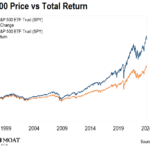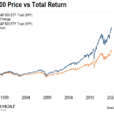
In their third and final estimate of the US GDP for the fourth quarter of 2015, the Bureau of Economic Analysis (BEA) reported that the economy was growing at a +1.38% annualized rate, up +0.38% from their previous estimate for the fourth quarter, but still down -0.61% from the third quarter.
The improvement was broadly based, with the revision to consumer expenditures for services having the greatest impact (+0.34%). Exports (+0.09%) and imports (+0.02%) also improved, as did commercial fixed investment (+0.04%) and governmental expenditures (+0.03%).
However economic growth provided by consumer spending on goods was revised downward still further, with the contribution to the headline growth dropping another -0.06%. And the contribution from inventories removed another -0.08% from the headline.
The BEA’s treatment of inventories can introduce noise and seriously distort the headline number over short terms — which the BEA admits by also publishing a secondary headline that excludes the impact of inventories. The BEA’s “bottom line” (their “Real Final Sales of Domestic Product”) was significantly improved in this revision, gaining +0.46% — although it remains over a full percent lower than was reported for the prior quarter.
Annualized household disposable income was revised slightly downward in this report. Real annualized per capita disposable income was reported to be $38,303 per annum, down $17 from the previous estimate. The household savings rate was revised downward to 5.0% — which is now unchanged from the prior quarter.
For this revision the BEA assumed an effective annualized deflator of 0.94%. During the same quarter (October 2015 through December 2015) the inflation recorded by the Bureau of Labor Statistics (BLS) in their CPI-U index was a very similar 0.93%. Slightly over estimating inflation results in slightly pessimistic growth rates, and if the BEA’s “nominal” data was deflated using CPI-U inflation information the headline growth number would be a marginally better +1.41%.
Among the notable items in the report :
— The headline contribution from consumer expenditures for goods was cut to +0.36% (down -0.06% from the earlier estimate and down -0.72% — more than two thirds — from the prior quarter).
— The contribution to the headline from consumer services improved substantially to +1.30% (up +0.34% from the previous report and also up +0.34% from the third quarter). The combined consumer contribution to the headline number was +1.66%, down -0.38% (about one-fourth) from 3Q-2015.
— The headline contribution from commercial private fixed investments remained minor at +0.06%, and down a material -0.54% from the prior quarter.
— The contribution from inventories remained negative, subtracting -0.22% from the headline number. This was an improvement of +0.49% from the -0.71% recorded in 3Q-2015. It bears repeating that the BEA’s inventory numbers are exceptionally noisy, subject to significant distortions/anomalies caused by commodity price swings while representing a zero reverting (and long term zero sum) series.
— Governmental spending added +0.02% to the headline. This is down -0.30% from the prior quarter.
— The contribution to the headline number from exports remained in contraction at -0.25% (up +0.09% from the previous estimate but down -0.34% from the prior quarter).
— Imports generated +0.11% growth in the BEA’s model of the economy, up some +0.02% from the previous report and up +0.46% from the prior quarter.
— The “real final sales of domestic product” was up a significant +0.46% from the previous estimate, and is now reported to be growing at a +1.60% annualized rate. However, this remains down more than a full percent from the +2.70% in the prior quarter. This is the BEA’s “bottom line” measurement of the economy and it excludes the reported inventory contraction.
— As mentioned above, real per-capita annual disposable income was revised slightly downward by $17 in this report, while the household savings rate declined in concert with the softening incomes. It is important to keep this line item in perspective. Real per-capita annual disposable income is up only +4.43% in aggregate since the second quarter of 2008 — a meager annualized +0.58% growth rate over the past 30 quarters. Meanwhile, according to Sentier Research, median incomes during the same time span have contracted by roughly 4%.















